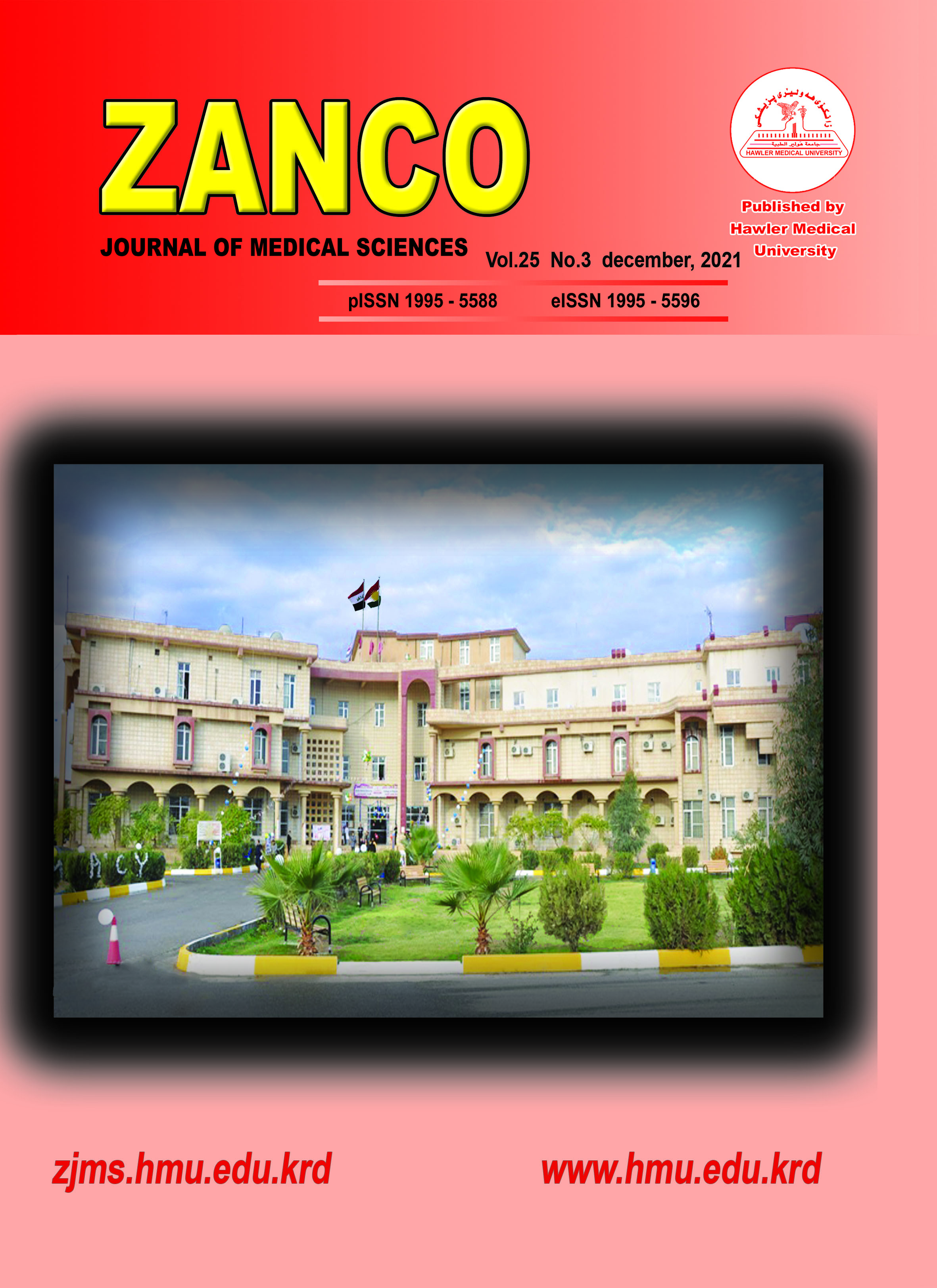Compliance with venous thromboembolism guideline after delivery at Maternity Teaching Hospital, Erbil city, Iraq
Copyright (c) 2021 Parween M Nawkhas, Shahla K Alalaf (Author)

This work is licensed under a Creative Commons Attribution-NonCommercial-ShareAlike 4.0 International License.
- Articles
- Submited: September 14, 2020
-
Published: December 23, 2021
Abstract
Background and objective: Venous thromboembolism is a leading cause of maternal morbidity and mortality. Few published articles have evaluated obstetricians' compliance with thromboprophylaxis guidelines, especially after vaginal delivery. This study aimed to assess obstetricians’ adherence to postpartum thromboprophylaxis guidelines and correlate adherence with the risk factors for venous thromboembolism after vaginal and cesarean delivery.
Methods: A cross-sectional study involving 981 women delivered at the Maternity Teaching Hospital, Erbil city, Kurdistan Region, Iraq, was conducted. Obstetricians' compliance with the thromboprophylaxis guideline regarding dose, duration, and indications were recorded. We assessed the risk factors for thromboembolism using the 2015 Royal College of Obstetricians and Gynecologists guideline.
Results: Medical thromboprophylaxis was required but not given to 93.2% of the women who delivered vaginally compared with 6.7% of the women who delivered by cesarean section. Women who delivered vaginally had a higher rate of age ˃ 36 years, parity of 3 and more, varicose vein, and current infection (P <0.001). The rates of preeclampsia, preterm labor, and prolonged labor were highest in the emergency cesarean section group (P <0.001). Factors associated with making a wrong decision were having no preeclampsia (odds ratio=15.4; 95% confidence interval=3.4–68.6), post-partum hemorrhage (odds ratio=15.3; 95% confidence interval=2.0–114.2), and vaginal delivery (odds ratio=250.2; 95% confidence interval=110.6–566.0).
Conclusion: Obstetricians' compliance with postpartum thromboprophylaxis in the hospital was low, especially after vaginal delivery.
Metrics
References
- Devis P, Knuttinen G. Deep venous thrombosis in pregnancy: Incidence, pathogenesis and endovascular management. Cardio Vasc Diagn Ther. 2017; 7:S300–S19. https://doi.org/10.21037/cdt.2017.10.08.
- Wu P, Poole T, Pickett J, Bhat A, Lees CH. Current obstetric guidelines on thromboprophylaxis in the United Kingdom: evidence based medicine? EBCOG. 2013; 168(1):7–11. https://doi.org/10.1016/j.ejogrb.2012.12.022.
- Chen Y, Dai Y, Song J, Wei L, Ma Y, Tian N, et al. Establishment of a risk assessment tool for pregnancy-associated venous thromboembolism and its clinical application: protocol for a prospective observational study in Beijing. BMC Pregnancy Childbirth. 2019; 19:294. https://doi.org/10.1186/s12884-019-2448-7.
- Abdul Sultan A, West J, Tata L, Fleming K, Nelson-Piercy K, Grainge M. Risk of first venous thromboembolism in and around pregnancy: a population-based cohort. BJH. 2012; 156(3): 366–73. https://doi.org/10.1111/j.1365-2141.2011.08956.x.
- Blondon M, Casini A, Hoppe K, Boehlen F, Righini M, Smith N. Risks of venous thromboembolism after cesarean sections: a metaanalysis. Chest. 2016; 150(3):572–96. https://doi.org/10.1016/j.chest.2016.05.021.
- RathnW, Tsikouras P, Von Tempelhoff F. Pharmacological Thromboprophylaxis during pregnancy and puerperium: recommendation from current guidelines and their critical comparison. Z Geburtshilfe Neonatol. 2016; 220(03):95–105. https://doi.org/10.1055/s-0042-106654.
- Reducing the Risk of Venous Thromboembolism during Pregnancy and the Puerperium. Green-top Guideline No. 37a April 2015 https://www.rcog.org.uk/globalassets/documents/guidelines/gtg-37a.pdf (Accessed on May 4,2020)
- ACOG Practice Bulletin No. 196: Thromboembolism in Pregnancy. Obstet Gynecol. 2018; 132(1):1–17. https://doi.org/10.1097/AOG.0000000000002706.
- Seeho K, Nippita A, Roberts L, Morris J. Venous thromboembolism prophylaxis during and following caesarean section: a survey of clinical practice. Aust N Z J Obstet Gynaecol. 2016; 56(1):54–9. https://doi.org/10.1111/ajo.12393.
- Goeckea T, Voigta F, Rathb W. Thromboprophylaxis following cesarean section – a nation-wide survey from Germany. J Matern Fetal Neonatal Med. 2019; 33(4):1–7. https://doi.org/10.1080/14767058.2018.1550064.
- Hawkins T, Lange I, Gibson P. Compliance with a perinatal prophylaxis policy for prevention of venous thromboembolism after caesarean section. J Obstet Gynaecol Can. 2008; 30(12): 1110–7. https://doi.org/10.1016/S1701-2163(16)34020-8.
- Girdiri M, Sant M, Philips K.Thromboprophylaxis for caesarean section—how can uptake and coverage be improved? Journal Obstet Gynaecol. 2009; 24(4):4392–4. https://doi.org/10.1080/01443610410001685510
- Crowley P, Noon C, Higgins R, O'Shea S. Multicenter study of thromboprophylaxis in pregnancy. Ir Med J. 2017; 110(5):567.
- Donnelly C, Raglan B, Bonanno C, Schulkin J, D'Alton M. Practice patterns and preferences of obstetricians and gynecologists regarding thromboprophylaxis at the time of Cesarean section. Matern Fetal Neonatal Med. 2014; 27(18):1870–3. https://doi.org/10.3109/14767058.2014.898057.
- AndersonJr F, Spencer F. Risk factors for venous thromboembolism. Circulation. 2003; 107(23):1. https://doi.org/10.1161/01.CIR.0000078469.07362.E6.
- Tan K, Wisdom J.Thromboprophylaxis post vaginal delivery: Are we forgetting it? Audit on thromboprophylaxis prescription post vaginal births. J Obstet Gynaecol. 2006; 26(1):27–9. https://doi.org/10.1080/01443610500363956.
- Grille S, Vitureira G, Morán R, Retamosa L, Alonso V, Gómez M, et al. Compliance with the 2009 Royal College of Obstetricians and Gynaecologists guidelines for venous thromboembolic disease prophylaxis in pregnancy and postpartum period in Uruguay. Blood Coagul Fibrin. 2018; 29(3):252–6. https://doi.org/10.1097/mbc.0000000000000708.
- Hayes-Ryan D, Byrne M. Prevention of thrombosis in pregnancy: How practical are consensus derived clinical practice guidelines? J Obstet Gynaecol. 2012; 32:740–2. https://doi.org/10.3109/01443615.2012.693982.
- Thromboprophylaxis during pregnancy, labour and after vaginal delivery. RCOG guideline No. 37 January 2004. http://muppet.pbworks.com/f/Thromboprophylaxis_no037.pdf. Accessed 31 May 2021.
- Jacobsen F, Skjeldestad E, Sandset M. Incidence and risk patterns of venous thromboembolism in pregnancy and puerperium—a register-based case-control study. AJOG. 2008; 198(2):233. https://doi.org/10.1016/j.ajog.2007.08.041.
- Greer A. Prevention of venous thromboembolism in pregnancy. Best Pract Resch. 2003; 16(2):261–78. https://doi.org/10.1016/S1521-6926(02)00095-6.
- Lindqvist P, Dahlback B, Marsal K. Thrombotic risk during pregnancy: a population study. Obstet Gynecol. 1999; 94:595–9.
- Brenner B. Haemostatic changes in pregnancy. Thromb Res. 2004; 114:409–14. https://doi.org/10.1016/j.thromres.2004.08.004.
- James AH, Jamison MG, Brancazio LR, Myers ER. Venous thromboembolism during pregnancy and the postpartum period: incidence, risk factors and mortality. Am J Obstet Gynecol. 2006; 194(5):1311–5. https://doi.org/10.1016/j.ajog.2005.11.008.





